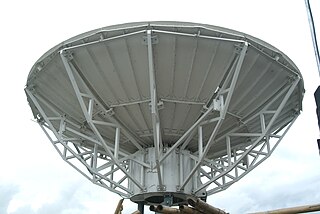
Simple Mail Transfer Protocol (SMTP) is an Internet standard for email transmission. First defined by RFC 821 in 1982, it was updated in 2008 with Extended SMTP additions by RFC 5321; which is the protocol in widespread use today.
In telecommunication, the term semiautomatic switching system has the following meanings:
- In telephone systems, a switching system in which telephone operators receive call instructions orally from users and complete them by automatic equipment.
- At tape relay intermediate stations, the manual routing or rerouting of taped messages without rekeying them.

The UNIVAC I was the first commercial computer produced in the United States. It was designed principally by J. Presper Eckert and John Mauchly, the inventors of the ENIAC. Design work was started by their company, Eckert–Mauchly Computer Corporation (EMCC), and was completed after the company had been acquired by Remington Rand. In the years before successor models of the UNIVAC I appeared, the machine was simply known as "the UNIVAC".
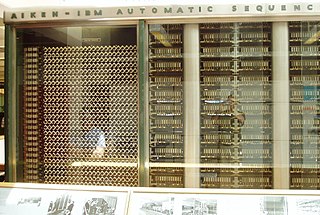
The IBM Automatic Sequence Controlled Calculator (ASCC), called Mark I by Harvard University’s staff, was a general purpose electromechanical computer that was used in the war effort during the last part of World War II.

The answering machine, answerphone or message machine, also known as telephone answering machine in the UK and some Commonwealth countries, ansaphone or ansafone, or telephone answering device (TAD), is used for answering telephones and recording callers' messages.

Monaural or monophonic sound reproduction is sound intended to be heard as if it were emanating from one position. This contrasts with stereophonic sound or stereo, which uses two separate audio channels to reproduce sound from two microphones on the right and left side, which is reproduced with two separate loudspeakers to give a sense of the direction of sound sources. In mono, only one loudspeaker is necessary, but, when played through multiple loudspeakers or headphones, identical signals are fed to each speaker, resulting in the perception of one-channel sound "imaging" in one sonic space between the speakers. Monaural recordings, like stereo ones, typically use multiple microphones fed into multiple channels on a recording console, but each channel is "panned" to the center. In the final stage, the various center-panned signal paths are usually mixed down to two identical tracks, which, because they are identical, are perceived upon playback as representing a single unified signal at a single place in the soundstage. In some cases, multitrack sources are mixed to a one-track tape, thus becoming one signal. In the mastering stage, particularly in the days of mono records, the one- or two-track mono master tape was then transferred to a one-track lathe intended to be used in the pressing of a monophonic record. Today, however, monaural recordings are usually mastered to be played on stereo and multi-track formats, yet retain their center-panned mono soundstage characteristics.
Internet Relay Chat services is a name for a set of features implemented on many modern Internet Relay Chat networks. Services are automated bots with special status which are generally used to provide users with access with certain privileges and protection. They usually implement some sort of login system so that only people on the access control list can obtain these services.
Store and forward is a telecommunications technique in which information is sent to an intermediate station where it is kept and sent at a later time to the final destination or to another intermediate station. The intermediate station, or node in a networking context, verifies the integrity of the message before forwarding it. In general, this technique is used in networks with intermittent connectivity, especially in the wilderness or environments requiring high mobility. It may also be preferable in situations when there are long delays in transmission and variable and high error rates, or if a direct, end-to-end connection is not available.
6to4 is an Internet transition mechanism for migrating from Internet Protocol version 4 (IPv4) to version 6 (IPv6), a system that allows IPv6 packets to be transmitted over an IPv4 network without the need to configure explicit tunnels. Special relay servers are also in place that allow 6to4 networks to communicate with native IPv6 networks.

The Friden Flexowriter was a teleprinter, a heavy-duty electric typewriter capable of being driven not only by a human typing, but also automatically by several methods, including direct attachment to a computer and by use of paper tape.
Broadcast automation incorporates the use of broadcast programming technology to automate broadcasting operations. Used either at a broadcast network, radio station or a television station, it can run a facility in the absence of a human operator. They can also run in a "live assist" mode when there are on-air personnel present at the master control, television studio or control room.
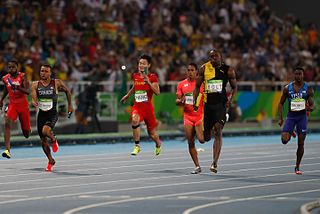
The 4 × 100 metres relay or sprint relay is an athletics track event run in lanes over one lap of the track with four runners completing 100 metres each. The first runners must begin in the same stagger as for the individual 400 m race. A relay baton is carried by each runner. Prior to 2018, the baton had to be passed within a 20 m changeover box, preceded by a 10-metre acceleration zone. With a rule change effective November 1, 2017 that zone was modified to include the acceleration zone as part of the passing zone, making the entire zone 30 metres in length. The outgoing runner cannot touch the baton until it has entered the zone, the incoming runner cannot touch the baton after it has left the zone. The zone is usually marked in yellow, frequently using lines, triangles or chevrons. While the rule book specifies the exact positioning of the marks, the colors and style are only "recommended". While most legacy tracks will still have the older markings, the rule change still uses existing marks. Not all governing body jurisdictions have adopted the rule change.
SORBS is a list of e-mail servers suspected of sending or relaying spam. It has been augmented with complementary lists that include various other classes of hosts, allowing for customized email rejection by its users.
Power-system automation is the act of automatically controlling the power system via instrumentation and control devices. Substation automation refers to using data from Intelligent electronic devices (IED), control and automation capabilities within the substation, and control commands from remote users to control power-system devices.
A subaudible tone is a tone that is used to trigger an automated event at a radio station. A subaudible tone is audible; however, it is usually at a low level that is not noticeable to the average listener at normal volumes. It is a form of in-band signaling.
The Number Five Crossbar Switching System is a telephone switch for telephone exchanges designed by Bell Labs and manufactured by Western Electric starting in 1947. It was used in the Bell System principally as a Class 5 telephone switch in the public switched telephone network (PSTN) until the early 1990s, when it was replaced with electronic switching systems. Variants were used as combined Class 4 and Class 5 systems in rural areas, and as a TWX switch.
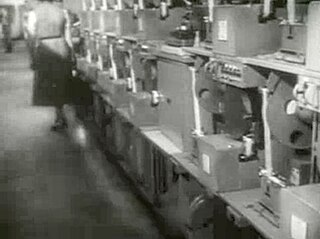
Plan 55-A was one in a series of store and forward message switching systems developed by Western Union and used from 1948 to 1976 for processing telegrams. It is an automated successor to Plan 51, which commenced service in 1951 in a nationwide network of the U.S. Air Force, but required semi-automatic operation.

Konversation is an Internet Relay Chat (IRC) client built on the KDE Platform and is free software released under the terms of the GNU General Public License. Konversation is currently maintained in the KDE Extragear Network module, which means that it has its own release cycle which is independent from the main KDE applications. It is the default IRC client in many prominent Linux distributions, such as openSUSE, the KDE spin of Fedora, and Kubuntu.
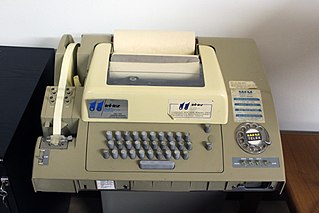
The telex network was a public switched network of teleprinters similar to a telephone network, for the purposes of sending text-based messages. Telex was a major method of sending written messages electronically between businesses in the post-World War II period. Its usage went into decline as the fax machine grew in popularity in the 1980s.



